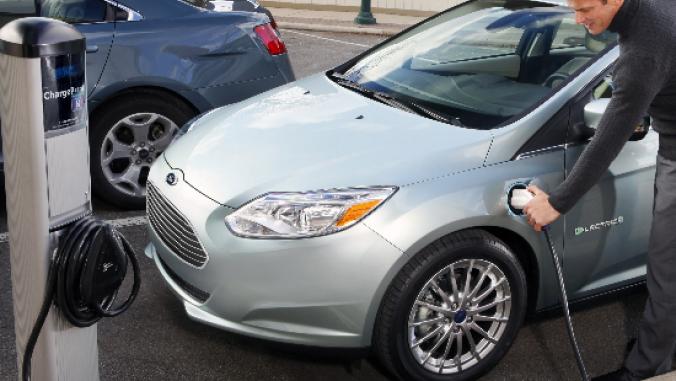Ford's Multi-Pronged Fuel Economy Strategy: How The Fusion S Lost 125 Pounds
<p>When improving fuel economy, there is no one strategy that trumps all others. Ford has taken a four-part approach, focusing on design efficiency, aerodynamics, weight reduction and high-value fuel economy technology.<br /> </p>

EcoBoost engine - photo by Jonathan Bardelline
[Editor's Note: GreenBiz.com editor Jonathan Bardelline traveled to Michigan this week to cover Ford's green-car announcements; you can read his other reports here and here.]
When improving fuel economy, there is no one strategy that trumps all others. Ford has taken a four-part approach, focusing on design efficiency, aerodynamics, weight reduction and high-value fuel economy technology.
The heart of Ford's strategy is its EcoBoost engine technology, said Nizar Trigui, who works in Ford's vehicle energy management engineering, at a press event Ford held yesterday. [Full disclosure: Ford paid for my travel to Michigan and lodging for the event.]
Ford's fuel economy and tailpipe carbon dioxide emissions strategy, Trigui said, includes making fuel economy the reason people buy Ford vehicles, providing the best-in-segment fuel economy for new and significantly refreshed vehicles, and offering showroom fuel economy competitiveness.
Recent data from the U.S. Environmental Protection Agency shows that Ford's car and truck fleet fuel economy improved 20 percent between 2004 and 2008, an improvement that is more than twice the industry average and about twice that of the next carmaker on the list. Ford's CO2 emissions were reduced 16 percent in the same timeframe.
To make further improvements, Ford is tackling four key areas, and within them, Ford is researching a number of what it calls 1 percenters, strategies that each improve fuel economy by 1 percent or more.
To improve design efficiency, Ford is utilizing its entire global operations by educating employees about how every decision they make can effect fuel economy and putting engineers and senior management through a Design for Energy Efficiency training course.
Along with educating employees, Ford is learning from them as well by running online forums and a website for employees to share efficiency ideas and receive compensation for viable suggestions. "When we opened it, we had a flood of ideas," Trigui said.
Ideas that Ford has aggressively pursued include gear shifting optimization, brake drag, tire rolling resistance and engine and transmission stabilized temperatures.
With the engine and transmission temperature strategy, Ford has been working to make sure those parts reach the correct temperatures for optimal and efficient performance as quickly as possible.
In aerodynamics, Ford is using tools that allows it to assess, as well as optimize, aerodynamics during the design phase. For every 10 percent reduction in aerodynamic drag, fuel economy is increased by about 1 percent for cars and 2 percent for trucks.
In the realm of weight reduction, Ford is aiming to reach reductions of 250 to 750 pounds in the mid-term (the company has a range of near, mid and long-term plans that stretch out to 2030). For every 10 percent reduction in weight, fuel consumption improves by 3 percent.
In the Fusion S, Ford reduced the radiator size by one-third and made the wheels lighter, bringing the vehicle's weight down by 125 pounds. The latest Lincoln MKT has a 40 percent lighter liftgate made possible by replacing steel with magnesium and aluminum, a change that also provides a 2 percent increase in fuel economy.
{related_content}While the company is currently maintaining vehicle weights while adding features and technology, it's working to also bring down vehicle weights, which will allow weight reduction in other parts, like EcoBoost engines.
Lastly, Ford's work in high-value fuel economy technology has focused on items like underbelly aeroshields, deceleration fuel shut-off and electric power assisted steering, a technology that is expected to be in 32 percent of Ford vehicles in 2010 and 84 percent in 2013.
In electric power assisted steering, which can improve fuel economy by 3 percent, the steering is powered by an electric motor connected to the vehicle's battery instead of being assisted by an engine-mounted hydraulic pump
Technologies like those that were added to the 2010 Fusion S gave the vehicle a 17 percent improvement in fuel economy over the 2009 version.
EcoBoost engine - photo by Jonathan Bardelline





